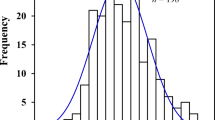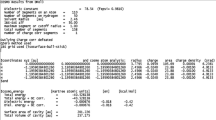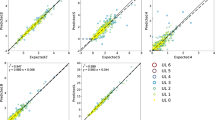Abstract
Performance of COSMO-RS method as a tool for partition and distribution modeling in 20 solvent pairs—composed of neutral or acidic aqueous solution and organic solvents of different polarity, ranging from alcohols to toluene and hexane—was evaluated. Experimental partition/distribution data of lignin-related and drug-like compounds (neutral, acidic, moderately basic) were used as reference. Several aspects of partition modeling were addressed: accounting for mutual saturation of aqueous and organic phases, variability of systematic prediction errors across solvent pairs, taking solute ionization into account. COSMO-RS was found to predict extraction outcome for both ligneous and drug-like compounds in various solvent pairs fairly well without any additional empirical input. The solvent-specific systematic errors were found to be moderate, despite being statistically significant, and related to the solvent hydrophobicity. Accounting for mutual solubilities of the two liquids was proven crucial in cases where water was considerably soluble in the organic solvent. The root mean square error of a priori logP prediction varied, depending mainly on the solvent pair, from 0.2 to 0.7, overall value being 0.6 log units. The accuracy was higher in case of hydrophilic than hydrophobic solvents. The logD predictions were less accurate, due to pKa prediction being an additional source of error, and also because of the complexity of modeling the behaviour of ionic species in the two-phase system. A simple correction for partitioning of free ions was found to notably improve logD prediction accuracy in case of the most hydrophilic organic phase (butanol/water).







Similar content being viewed by others
Notes
One imaginary frequency was discovered in one of the conformers of compound B17. However, considering the low numerical value of the frequency and extremely low relative abundance of the conformer, it was deemed unlikely to influence the results and was ignored.
Both literature data and computations show that the effect of small (few degrees) temperature variations on solubility is comparable with or lower than the expected error of solubility determinations (mismatch of the values from different literature sources). Therefore the difference between the mutual solubilities of liquids at 25 and ca 23 °C (conditions of logP/logD determinations) was assumed to be negligible. Therefore experimental data from Table 1 was used in logP calculations at 23 °C without alterations.
It was observed earlier [50] that in case of compounds with strongly lipophilic ionized forms the concentration of ions (in the form of ion associates) even in relatively hydrophobic organic phases (octanol, toluene) may be comparable to or exceed the concentration of the neutral species. In such cases Eq. 4 is not adequate and some form of Eq. 5 must be used.
References
Hou TJ, Xu XJ (2003) ADME evaluation in drug discovery. 3. Modeling blood-brain barrier partitioning using simple molecular descriptors. J Chem Inf Comput Sci 43:2137–2152. https://doi.org/10.1021/ci034134i
Hou T, Wang J, Li Y (2007) ADME evaluation in drug discovery. 8. The prediction of human intestinal absorption by a support vector machine. J Chem Inf Model 47:2408–2415. https://doi.org/10.1021/ci7002076
Saiakhov RD, Stefan LR, Klopman G (2000) Multiple computer-automated structure evaluation model of the plasma protein binding affinity of diverse drugs. Perspect Drug Discov Des 19:133–155. https://doi.org/10.1023/A:1008723723679
Hansch C, Leo A, Mekapati SB, Kurup A (2004) QSAR and ADME. Bioorg Med Chem 12:3391–3400. https://doi.org/10.1016/j.bmc.2003.11.037
Zhao YH, Yuan X, Su LM et al (2009) Classification of toxicity of phenols to Tetrahymena pyriformis and subsequent derivation of QSARs from hydrophobic, ionization and electronic parameters. Chemosphere 75:866–871. https://doi.org/10.1016/j.chemosphere.2009.01.055
Papa E, Villa F, Gramatica P (2005) Statistically validated QSARs, based on theoretical descriptors, for modeling aquatic toxicity of organic chemicals in Pimephales promelas (Fathead Minnow). J Chem Inf Model 45:1256–1266. https://doi.org/10.1021/ci050212l
Voutchkova AM, Kostal J, Steinfeld JB et al (2011) Towards rational molecular design: derivation of property guidelines for reduced acute aquatic toxicity. Green Chem 13:2373–2379. https://doi.org/10.1039/C1GC15651A
Lipinski CA, Lombardo F, Dominy BW, Feeney PJ (1997) Experimental and computational approaches to estimate solubility and permeability in drug discovery and development settings. Adv Drug Deliv Rev 23:3–25. https://doi.org/10.1016/S0169-409X(96)00423-1
Mannhold R, Poda GI, Ostermann C, Tetko IV (2009) Calculation of molecular lipophilicity: state-of-the-art and comparison of logP methods on more than 96,000 compounds. J Pharm Sci 98:861–893. https://doi.org/10.1002/jps.21494
Bannan CC, Burley KH, Chiu M et al (2016) Blind prediction of cyclohexane–water distribution coefficients from the SAMPL5 challenge. J Comput Aided Mol Des 30:927–944. https://doi.org/10.1007/s10822-016-9954-8
Klamt A (1995) Conductor-like screening model for real solvents: a new approach to the quantitative calculation of solvation phenomena. J Phys Chem 99:2224–2235. https://doi.org/10.1021/j100007a062
Klamt A, Jonas V, Bürger T, Lohrenz JCW (1998) Refinement and parametrization of COSMO-RS. J Phys Chem A 102:5074–5085. https://doi.org/10.1021/jp980017s
Klamt A, Eckert F, Arlt W (2010) COSMO-RS: an alternative to simulation for calculating thermodynamic properties of liquid mixtures. Annu Rev Chem Biomol Eng 1:101–122. https://doi.org/10.1146/annurev-chembioeng-073009-100903
Eckert F, Klamt A (2002) Fast solvent screening via quantum chemistry: COSMO-RS approach. AIChE J 48:369–385. https://doi.org/10.1002/aic.690480220
Klamt A (2018) The COSMO and COSMO-RS solvation models. Wiley Interdiscip Rev Comput Mol Sci 8:e1338. https://doi.org/10.1002/wcms.1338
Blumenthal LC, Jens CM, Ulbrich J et al (2016) Systematic identification of solvents optimal for the extraction of 5-hydroxymethylfurfural from aqueous reactive solutions. ACS Sustain Chem Eng 4:228–235. https://doi.org/10.1021/acssuschemeng.5b01036
Spieß AC, Eberhard W, Peters M et al (2008) Prediction of partition coefficients using COSMO-RS: solvent screening for maximum conversion in biocatalytic two-phase reaction systems. Chem Eng Process 47:1034–1041. https://doi.org/10.1016/j.cep.2007.02.007
Preißinger M, Schwöbel JAH, Klamt A, Brüggemann D (2017) Multi-criteria evaluation of several million working fluids for waste heat recovery by means of Organic Rankine Cycle in passenger cars and heavy-duty trucks. Appl Energy 206:887–899. https://doi.org/10.1016/j.apenergy.2017.08.212
Bezold F, Weinberger ME, Minceva M (2017) Assessing solute partitioning in deep eutectic solvent-based biphasic systems using the predictive thermodynamic model COSMO-RS. Fluid Phase Equilib 437:23–33. https://doi.org/10.1016/j.fluid.2017.01.001
Lotfi M, Moniruzzaman M, Sivapragasam M et al (2017) Solubility of acyclovir in nontoxic and biodegradable ionic liquids: COSMO-RS prediction and experimental verification. J Mol Liq 243:124–131. https://doi.org/10.1016/j.molliq.2017.08.020
Jeliński T, Cysewski P (2017) Screening of ionic liquids for efficient extraction of methylxanthines using COSMO-RS methodology. Chem Eng Res Des 122:176–183. https://doi.org/10.1016/j.cherd.2017.04.015
Song Z, Zeng Q, Zhang J et al (2016) Solubility of imidazolium-based ionic liquids in model fuel hydrocarbons: a COSMO-RS and experimental study. J Mol Liq 224:544–550. https://doi.org/10.1016/j.molliq.2016.10.026
Liu Y-R, Thomsen K, Nie Y et al (2016) Predictive screening of ionic liquids for dissolving cellulose and experimental verification. Green Chem 18:6246–6254. https://doi.org/10.1039/C6GC01827K
Garcia-Chavez LY, Hermans AJ, Schuur B, de Haan AB (2012) COSMO-RS assisted solvent screening for liquid–liquid extraction of mono ethylene glycol from aqueous streams. Sep Purif Technol 97:2–10. https://doi.org/10.1016/j.seppur.2011.11.041
Mokrushina L, Buggert M, Smirnova I et al (2007) COSMO-RS and UNIFAC in prediction of micelle/water partition coefficients. Ind Eng Chem Res 46:6501–6509. https://doi.org/10.1021/ie0704849
Klamt A, Eckert F, Reinisch J, Wichmann K (2016) Prediction of cyclohexane-water distribution coefficients with COSMO-RS on the SAMPL5 data set. J Comput Aided Mol Des 30:959–967. https://doi.org/10.1007/s10822-016-9927-y
Wittekindt C, Klamt A (2009) COSMO-RS as a predictive tool for lipophilicity. QSAR Comb Sci 28:874–877. https://doi.org/10.1002/qsar.200810175
Ingram T, Richter U, Mehling T, Smirnova I (2011) Modelling of pH dependent n-octanol/water partition coefficients of ionizable pharmaceuticals. Fluid Phase Equilib 305:197–203. https://doi.org/10.1016/j.fluid.2011.04.006
Ikeda H, Chiba K, Kanou A, Hirayama N (2005) Prediction of solubility of drugs by conductor-like screening model for real solvents. Chem Pharm Bull 53:253–255
Wille S, Buggert M, Mokrushina L et al (2010) Effect of electrolytes on octanol-water partition coefficients: calculations with COSMO-RS. Chem Eng Technol 33:1075–1082. https://doi.org/10.1002/ceat.201000045
Oleszek-Kudlak S, Grabda M, Shibata E et al (2005) Application of the conductor-like screening model for real solvents for prediction of the aqueous solubility of chlorobenzenes depending on temperature and salinity. Environ Toxicol Chem 24:1368–1375. https://doi.org/10.1897/04-100R1.1
Goral M, Wisniewska-Goclowska B, Skrzecz A et al (2005) IUPAC-NIST solubility data series. 81. Hydrocarbons with water and seawater—revised and updated. Part 4. C6H14 hydrocarbons with water. J Phys Chem Ref Data 34:709–753. https://doi.org/10.1063/1.1796651
Goral M, Wisniewska-Goclowska B, Skrzecz A et al (2005) IUPAC-NIST solubility data series. 81. Hydrocarbons with water and seawater—revised and updated. Part 5. C7 hydrocarbons with water and heavy water. J Phys Chem Ref Data 34:1399–1487. https://doi.org/10.1063/1.1840737
Mączyński A, Oracz P, Wiśniewska-Gocłowska B et al (2010) IUPAC-NIST solubility data series. 88. Esters with water—revised and updated. Part 2. C5 and C6 esters. J Phys Chem Ref Data 39:013102. https://doi.org/10.1063/1.3243973
Horvath AL, Getzen FW (1995) Halogenated methanes with water. Oxford University Press, Oxford
Goral M, Wisniewska-Goclowska B (2007) IUPAC-NIST solubility data series. 82. Alcohols with water—revised and updated: Part 1. C4 alcohols with water. J Phys Chem Ref Data 36:59–132. https://doi.org/10.1063/1.2366707
Goral M, Wisniewska-Goclowska B (2007) IUPAC-NIST solubility data series. 82. Alcohols with water—revised and updated: Part 5. C8–C17 alcohols with water. J Phys Chem Ref Data 36:685–731. https://doi.org/10.1063/1.2391321
Goral M, Wisniewska-Goclowska B (2007) IUPAC-NIST solubility data series. 82. Alcohols with water—revised and updated: Part 3. C6 alcohols with water. J Phys Chem Ref Data 36:399–443. https://doi.org/10.1063/1.2383067
Goral M, Wisniewska-Goclowska B (2007) IUPAC-NIST solubility data series. 82. Alcohols with water—revised and updated: Part 4. C 7 alcohols with water. J Phys Chem Ref Data 36:445–484. https://doi.org/10.1063/1.2389037
Góral M, Wiśniewska-Gocłowska B (2008) IUPAC-NIST solubility data series. 86. Ethers and ketones with water. Part 1. C2–C5 ethers with water. J Phys Chem Ref Data 37:1119–1146. https://doi.org/10.1063/1.2838022
Horvath AL, Getzen FW (1985) Halogenated benzenes, toluenes and phenols with water. Pergamon Press, Oxford
Tshepelevitsh S, Hernits K, Jenčo J et al (2017) Systematic optimization of liquid–liquid extraction for isolation of unidentified components. ACS Omega 2:7772–7776. https://doi.org/10.1021/acsomega.7b01445
TURBOMOLE V6.2 (2010) A development of University of Karlsruhe and Forschungszentrum Karlsruhe GmbH, 1989–2007, TURBOMOLE GmbH, since 2007. http://www.turbomole.com. Accessed 27 May 2018
TURBOMOLE V6.5 (2013) A development of University of Karlsruhe and Forschungszentrum Karlsruhe GmbH, 1989–2007, TURBOMOLE GmbH, since 2007. http://www.turbomole.com. Accessed 27 May 2018
Eckert F, Klamt A, COSMOtherm, Version C3.0, release 17.01; COSMOlogic GmbH & Co. KG. http://www.cosmologic.de. Accessed 27 May 2018
Klamt A (2003) Prediction of the mutual solubilities of hydrocarbons and water with COSMO-RS. Fluid Phase Equilib 206:223–235. https://doi.org/10.1016/S0378-3812(02)00322-9
Freire MG, Ventura SPM, Santos LMNBF. et al (2008) Evaluation of COSMO-RS for the prediction of LLE and VLE of water and ionic liquids binary systems. Fluid Phase Equilib 268:74–84. https://doi.org/10.1016/j.fluid.2008.04.009
Fukasawa T, Tominaga Y, Wakisaka A (2004) Molecular association in binary mixtures of tert-butyl alcohol–water and tetrahydrofuran–heavy water studied by mass spectrometry of clusters from liquid droplets. J Phys Chem A 108:59–63. https://doi.org/10.1021/jp031011s
Isele-Holder RE, Rabideau BD, Ismail AE (2012) Definition and computation of intermolecular contact in liquids using additively weighted voronoi tessellation. J Phys Chem A 116:4657–4666. https://doi.org/10.1021/jp3021886
Selberg S, Rodima T, Lõkov M et al (2017) Synthesis and properties of highly lipophilic phosphazene bases. Tetrahedron Lett 58:2098–2102. https://doi.org/10.1016/j.tetlet.2017.04.039
Abraham MH, Acree WE (2011) Hydrogen bond descriptors and other properties of ion pairs. New J Chem 35:1740. https://doi.org/10.1039/c1nj20324j
Zamora WJ, Curutchet C, Campanera JM, Luque FJ (2017) Prediction of pH-dependent hydrophobic profiles of small molecules from Miertus–Scrocco–Tomasi continuum solvation calculations. J Phys Chem B 121:9868–9880. https://doi.org/10.1021/acs.jpcb.7b08311
Chen C-S, Lin S-T (2016) Prediction of pH effect on the octanol–water partition coefficient of ionizable pharmaceuticals. Ind Eng Chem Res 55:9284–9294. https://doi.org/10.1021/acs.iecr.6b02040
Avdeef A (2012) Absorption and drug development: solubility, permeability, and charge state, 2nd edn. Wiley, Hoboken
Eckert F, Klamt A (2006) Accurate prediction of basicity in aqueous solution with COSMO-RS. J Comput Chem 27:11–19. https://doi.org/10.1002/jcc.20309
Acknowledgements
This work was supported by the Institutional Funding IUT20-14 from the Estonian Research Council and by the EU through the European Regional Development Fund (TK141 “Advanced materials and high-technology devices for energy recuperation systems”). Authors thank Dr. Jens Reinisch for helpful discussions. Authors also thank Dr. Joel Hawkins and Pfizer Inc. for helpful discussions and help in obtaining chemicals.
Author information
Authors and Affiliations
Corresponding author
Electronic supplementary material
Below is the link to the electronic supplementary material.
Rights and permissions
About this article
Cite this article
Tshepelevitsh, S., Hernits, K. & Leito, I. Prediction of partition and distribution coefficients in various solvent pairs with COSMO-RS. J Comput Aided Mol Des 32, 711–722 (2018). https://doi.org/10.1007/s10822-018-0125-y
Received:
Accepted:
Published:
Issue Date:
DOI: https://doi.org/10.1007/s10822-018-0125-y




